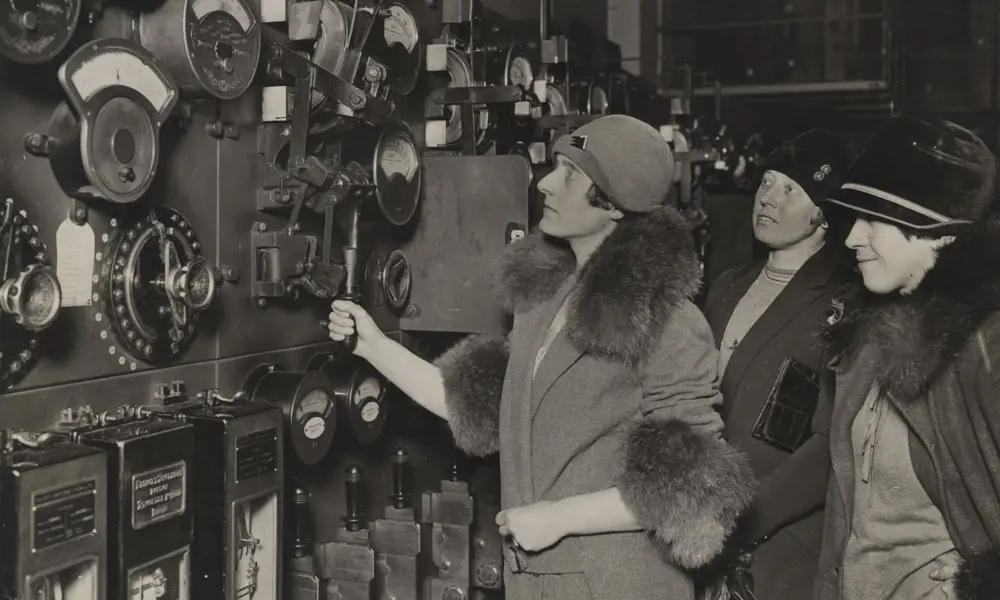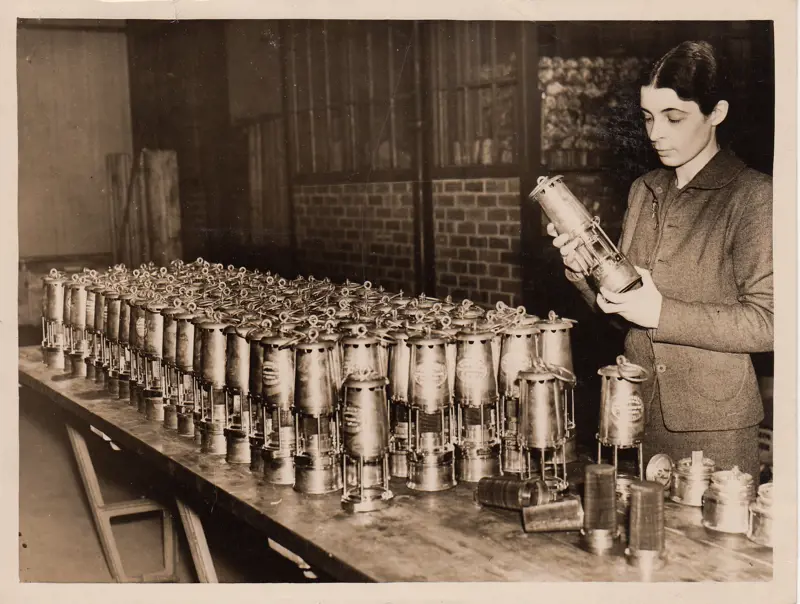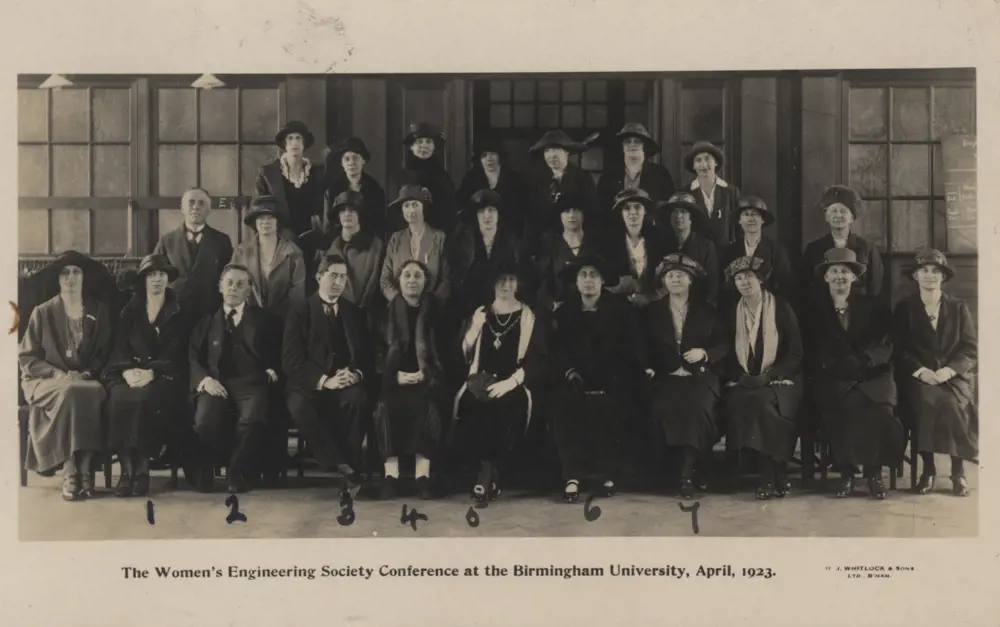
A century celebrating women engineers
While women had been involved in engineering before the First World War, the new and expanding range of industries that arose during the conflict, such as munitions and aeronautics, created more opportunities for women to work in engineering. Some women went from doing poorly paid piecework to managing and training all-female teams in factories. In 1919, after the war had ended, the Sex Disqualification (Removal) Act was passed: “A person shall not be disqualified by sex or marriage from the exercise of any public function, or from being appointed to or holding any civil or judicial office or post, or from entering or assuming or carrying on any civil profession or vocation, or for admission to any incorporated society.”
The society aimed to support the women who had worked throughout the war and did not want to go back to domestic work just because it was over
Margaret Partridge, Electrical Engineer
🔌 The women who spent her life working to electrify England to free women from domestic work
Margaret Partridge was a pioneer of electrical engineering and a member of WES and the Electrical Association for Women. She realised that electrification was the key to freeing women from domestic work and spent her life working to electrify England.
After completing a maths degree, she had a brief career as a teacher before deciding that it was not for her. Like many women, she trained as an engineering apprentice during the war and worked in munitions. After the war, she moved home to Devon where she set up her own electrical consulting business that provided electricity supplies for small towns and villages. In 1920, Margaret joined WES, where she advertised her new business in its journal with the slogan ‘Women for Women’s Work’.
Along with Dame Caroline Haslett DBE, she wrote The Electrical Handbook for Women, which taught women how to use appliances, do their own electrical repairs and teach the uses of electricity to other women.
Margaret’s company brought electricity to many homes for the first time. In the 1920s, she wired four English villages for electricity and, with Dame Caroline, established Electrical Enterprise Inc to ensure that rural homes could access electricity.
She also offered apprenticeships for young men and women leaving school: Beatrice Shilling OBE, the aeronautical engineer and racing driver, became an engineer through Margaret’s apprenticeship scheme.
Margaret also put on an exhibition of electric models and machines in Exeter to ‘stir up the women of Exeter to demand the installation of electricity’. From 1943 to 1945 she was President of WES and founded a munitions factory during the Second World War.

Laura Willson, Dame Caroline Haslett DBE and Margaret Partridge, who all worked on electrifying rural England. This image was originally published in the Leeds Mercury newspaper on Saturday 17 September 1927 © WES and IET Archives
This law meant that women could join professional organisations, although there was a still a bar for married women. WES was legally recognised the day after the act was passed. While the act allowed the society to exist, the parallel 1919 Restoration of Pre-War Practices Act contradicted it in many ways, as it forced lots of women to relinquish their wartime roles to the men who returned from war. The society aimed to support the women who had worked throughout the war and did not want to go back to domestic work just because it was over.
Its first President was Rachel Parsons who, like many early women engineers, came from an engineering family – her father, Charles Parsons OM KCB FRS, invented the steam turbine. During the war Rachel replaced her brother as a director on the company’s board and, along with her mother Lady Katherine Parsons, oversaw the recruitment and training of women munitions workers. Lady Katherine brought together the founders of WES – a group of inventors, engineers, campaigners and designers – to improve the rights of women in the workplace as traditional engineering societies continued to reject applications from women after the war.
Monica Maurice OBE, lighting engineer
💡 A lamp company director, apprentice engineer and women in engineering advocate
Monica Maurice OBE was a mine-lighting engineer who went on to become Managing Director and Chairman of the Wolf Safety Lamp Company. She joined WES in 1934 and was the first woman to be a member of the Association of Mining Electrical Engineers.
Monica was highly educated: she studied in Paris and Hamburg in the 1920s, before joining the Wolf Safety Lamp Company as secretary to the founder, her father, William Maurice. There, according to The Woman Engineer, she studied the techniques of electric mine lamp design, the manufacture of alkaline storage batteries, the methods of laying out colliery lamprooms and maintaining the efficient running order of installations.
During this time, Monica also trained as an apprentice engineer in Germany with the world’s largest and most celebrated firm of mine lamp makers. Two years later, she was made a director with responsibility for the operation of lamps at collieries across the UK. She also played an active role in establishing an international standard of lighting for mines.
Monica had plans drawn up for a ‘new model factory’ and designed new machinery, based on the suggestions of an employee who had changed the way that battery electrodes were made. In 1936, she organised the 14th annual WES conference in Sheffield, and members visited and toured her new model factory.
During the Second World War, Monica served on the British Standards Committee, investigating wartime standardisation of mine lamp bulbs, personal safety and safety footwear.
Monica was a strong advocate for women in engineering, a keen motorist, a qualified pilot and practised advanced aerobatics for fun. Her wedding dress, which she designed herself and was, for the time, a daring red, is in the Victoria and Albert Museum. She was awarded an OBE by HM The Queen in 1975.

Monica Maurice in 1939 © Wolf Safety Lamp Company
Early Years
Many of WES’s founding members had been involved in the suffrage movement, which in 1918 had contributed to women aged 30 being granted the vote. WES members recognised that although the vote had been given to some women, most of them working in the factories were under 30 and did not own property, so did not benefit. The seven founders drew up a constitution for a society that would help women gain training, employment and acceptance in the world of engineering. The early members had diverse careers, spanning electricity, medicine, house-building and aeronautics.
Rachel Parsons was one of the first three women to study mechanical sciences at the University of Cambridge, although women could not graduate at the time. She campaigned for equal access to technical schools and colleges, and co-founded Atalanta Ltd, an all-women engineering company that produced machine models with Annette Ashberry, its Managing Director and another founder of WES. Parsons also set up Girl Guides groups in her area, teaching practical skills and community-mindedness.
Dame Caroline Haslett DBE was also one of WES’s first members – she answered an advert for an organising secretary “with some experience of engineering”. She went on to edit WES’s journal, The Woman Engineer, and was later President of the society. She co-founded the Electrical Association for Women, an organisation that aimed to reduce women’s domestic workload by encouraging the use of electricity. She became one of the most influential women in the first half of the 20th century, and even spoke alongside President Harry S Truman in front of the White House in her role as President of the International Federation of Business and Professional Women.
Other members included Dorothée Pullinger MBE, who managed 7,000 women munitions workers during the First World War, before becoming director of Galloway Motors, where she ran an innovative apprenticeship programme for women and built the first car engineered by, and for, women* (‘An ingenious introduction to engineering’, Ingenia 74).
In the mid-century, membership of WES continued to grow and attract women from a range of disciplines, from Dr Winifred Hackett, a computer pioneer, to metallurgists, nuclear engineers and the UK’s first female railway engineer, among many others.

The Women’s Engineering Society’s 1923 conference © IET Archives
Marking the centenary
🛠️ Improving Wikipedia gender balance, an interactive online map and International Women in Engineering Day
Wikithons
Throughout its centenary year, WES is running Wikithons and inviting members of the public to help improve the gender balance of Wikipedia. Currently, women are underrepresented on Wikipedia in terms of both the number of women editors (less than 20%) and the number and length of articles written about them. Wikipedia is the fifth most visited website in the world, so the Wikithons help to train women to edit Wikipedia in the hopes of improving the gender balance of the site.
At a recent WES Wikithon, five new articles were published and 19 articles were improved. The volunteer editors made 61 edits that resulted in over 4,000 words being added to Wikipedia and the edited and new pages were viewed 750 times in the first week. The new articles included Monica Maurice OBE, an industrialist and the first, and for 40 years the only, woman member of the Association of Mining Electrical Engineers (see opposite); and Madeleine Nobbs, a building services engineer who was responsible for the re-provision of services to the Old Bailey in London after the Second World War, and was a President of WES.
WES Cenetary Trail
The WES Centenary Trail is commemorating women engineers though an interactive online map (launching in June) that records and shares the history of WES and its members with the public. Combined with the new and improved Wikipedia entries, it hopes to build an audience for local and women’s history, based on research into WES and other archives. Only 17.7% of biographies written in English are about women and a very small number of those entries are about women engineers. Wikipedia entries will be pulled through to populate the map with up to 200 pins to explore by the end of the project. The stories will be shared through local events, displays and social media.
Research for the WES Centenary Trail revealed the forgotten story of Jeanie Dicks, who undertook the electrification of Winchester Cathedral in 1934. At the time, the press was very interested in the novelty of a women taking on such a role and, as a result of the research, Jeanie now has her own Wikipedia page.
The Centenary Trail is funded by a grant from the National Lottery Heritage Fund. To find out more, visit their website , @WESCentenary on Twitter or @wes_centenary on Instagram.
International Women in Engineering Day
On 23 June, the sixth International Women in Engineering Day (INWED) will take place, a day that increases the profile of women in engineering. This year, it has a theme of ‘Transform the future’ and WES is encouraging participants around the world to demonstrate how they are transforming the future by encouraging more diversity in engineering. The celebrations will also include the announcement of the annual Top 50 Women in Engineering, which this year will focus on current and former apprentices.
INWED events have been planned around the world; from Madrid, to Canada and Panama. A group of female engineers from the University of Glasgow are working on a collaborative project with the University of Rwanda. In June, the engineers are travelling to Rwanda to deliver STEM workshops to the local community in Kigali to encourage local young people into careers in STEM.
WES encourages supporters to use its official hashtags #INWED19 and #TransformTheFuture to help raise the profile of women in engineering and highlight the career opportunities available.
Today
WES is a charity and a professional network. Today, its work is needed more than ever – according to the Office for National Statistics, only 16.5% of professional engineers in the UK are women, one of the lowest rates in Europe. In technical roles, women’s participation is even lower. The society continues to raise the profile of female engineers and shows girls that they can become engineers. It works to celebrate the present, remember the past and transform the future. WES runs STEM Returners, a programme for women returning to STEM after a career break, provides mentors for women working in STEM through MentorSet, runs the Top 50 Women in Engineering Awards each year, and runs International Women in Engineering Day every June. WES wants to see people embrace the idea that engineering is for everyone, by ensuring that while the world continues to change and develop, it opens opportunities to all, regardless of who they are.
***
This article has been adapted and updated (as of February 2024) from "A century celebrating women engineers", which originally appeared in the print edition of Ingenia 79 (June 2019).
Keep up-to-date with Ingenia for free
SubscribeOther content from Ingenia
Quick read

- Environment & sustainability
- Opinion
A young engineer’s perspective on the good, the bad and the ugly of COP27

- Environment & sustainability
- Issue 95
How do we pay for net zero technologies?
Quick read

- Transport
- Mechanical
- How I got here
Electrifying trains and STEMAZING outreach

- Civil & structural
- Environment & sustainability
- Issue 95